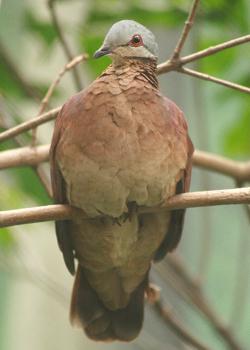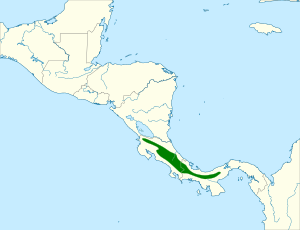Chiriqui quail-dove facts for kids
Quick facts for kids Chiriquí quail-dove |
|
|---|---|
 |
|
| Conservation status | |
| Scientific classification | |
| Genus: |
Zentrygon
|
| Species: |
chiriquensis
|
 |
|
| Synonyms | |
|
Geotrygon chiriquensis |
|
The Chiriquí quail-dove is a special type of bird that lives in the forests of Costa Rica and Panama. It's also called the rufous-breasted quail-dove because of its reddish chest. This bird is part of the Columbidae family, which includes all the doves and pigeons. Its scientific name is Zentrygon chiriquensis.
Contents
About the Chiriquí Quail-Dove
The Chiriquí quail-dove is unique because it's the only bird of its kind in its specific group. It was first described by a scientist named Philip Sclater in 1856. Sometimes, people used to think it was the same as other quail-doves, like the white-faced quail-dove or the lined quail-dove. But now, scientists agree it's its own distinct species.
What Does It Look Like?
The Chiriquí quail-dove is a medium-sized bird. Males are about 27 to 31 cm long, and females are similar, measuring 26 to 32 cm. They weigh around 295 to 308 grams.
- Head: The male has a dark gray cap on its head, which is lighter on the forehead. Its face is a pale yellowish-brown. It has a black stripe near its cheek and a thin black line going through its eye. The eye itself is brownish-orange, surrounded by bare red skin.
- Body: The bird's upper back and shoulders are a rich chestnut color. This changes to a purplish color on its upper back and then to an olive-green with a shiny look on its lower back.
- Underparts: Its chin is whitish. This color changes to reddish on its chest and sides. Then it becomes a light cinnamon-brown on its belly. The sides of its body are a darker cinnamon.
- Females and Young Birds: Female quail-doves look very much like the males, but their chest feathers are usually a bit darker. Young birds have a brown cap and upper body. Their underparts have dull black stripes.
Where Does It Live?
The Chiriquí quail-dove lives in Central America. You can find it from the Cordillera de Guanacaste in northern Costa Rica all the way to the Chiriquí and Veraguas provinces in western Panama.
It prefers to live in the lower parts of drier mountain forests. These are called the Talamancan montane forests.
- Caribbean Side: On the side of the mountains facing the Caribbean Sea, it usually lives at heights between 600 and 1700 meters (about 2,000 to 5,600 feet). Sometimes, it can be found as high as 2000 meters (about 6,500 feet).
- Pacific Side: On the side facing the Pacific Ocean, it typically lives between 1000 and 2500 meters (about 3,300 to 8,200 feet). Occasionally, it can be seen even higher, up to 3100 meters (about 10,200 feet).
How Does It Behave?
What It Eats
The Chiriquí quail-dove looks for food on the ground. It usually forages alone or sometimes in pairs. Its diet includes:
- Seeds
- Fallen fruit
- Small invertebrates (like insects or worms)
It usually feeds in places with lots of cover, like thick bushes. But sometimes, you might spot it along roads or trails early in the morning.
How It Raises Its Young
We don't know everything about the Chiriquí quail-dove's nesting habits. However, we know its nesting season includes August and September.
- Nest: It builds a shallow, cup-shaped nest. This nest is made from twigs and leaves.
- Location: The bird places its nest on a tree branch.
- Eggs: A female Chiriquí quail-dove usually lays two eggs at a time.
Its Song
The song of the Chiriquí quail-dove is quite simple. It's a single, steady note that sounds like wooOoh. This sound slowly gets louder. During the breeding season, the bird sings this song a lot from a perch.
Is It Endangered?
The IUCN (International Union for Conservation of Nature) has looked at the Chiriquí quail-dove's status. They have listed it as a species of Least Concern. This means it's not currently in immediate danger of disappearing.
This assessment is based on how large its living area is and how many birds are estimated to be in the population. Even though the population is thought to be slowly decreasing, it's still considered stable enough.
Scientists don't know a lot about this bird's life and how it interacts with its environment. More research and surveys are needed to truly understand its situation.
See also
 In Spanish: Paloma perdiz de Chiriquí para niños
In Spanish: Paloma perdiz de Chiriquí para niños


